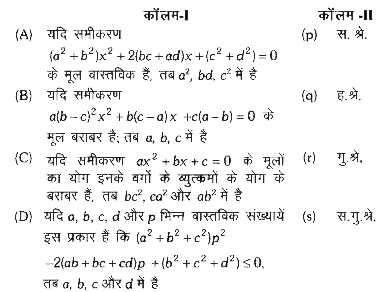यदि समीकरण ax2+bx+c=0 के भिन्न मूल x1,x2,x3 हों, तब
a=b=0,c∈R
a=c=0,b∈R
b2−4ac≥0
a=b=c=0
The correct Answer is:D
Step by step video, text & image solution for यदि समीकरण ax^(2)+bx+c=0 के भिन्न मूल x_(1),x_(2),x_(3) हों, तब by Maths experts to help you in doubts & scoring excellent marks in Class 12 exams.
Updated on:21/07/2023Topper's Solved these Questions
- वर्ग समीकरण एवं असमिकायें BOOK - ERRORLESS HINDICHAPTER - वर्ग समीकरण एवं असमिकायें EXERCISE - Solved Multiple Choice Questions (मूलों तथा गुणांकों के मध्य सम्बन्ध)
58 Videos
- वर्ग समीकरण एवं असमिकायें BOOK - ERRORLESS HINDICHAPTER - वर्ग समीकरण एवं असमिकायें EXERCISE - Solved Multiple Choice Questions (मूलों के उभयनिष्ठ होने का प्रतिबंध, वर्ग व्यंजक व मूलों की स्थिति)
18 Videos
- वर्ग समीकरण एवं असमिकायें BOOK - ERRORLESS HINDICHAPTER - वर्ग समीकरण एवं असमिकायें EXERCISE - JEE Advanced (Matrix Match type questions)
2 Videos
- लघुगणक और आंशिक भिन्नें BOOK - ERRORLESS HINDICHAPTER - लघुगणक और आंशिक भिन्नें EXERCISE - JEE Advanced (integer type questions)
8 Videos
- वृत्त तथा वृत्तों का निकाय BOOK - ERRORLESS HINDICHAPTER - वृत्त तथा वृत्तों का निकाय EXERCISE - JEE Advanced (Integer type questions)
20 Videos
Similar Questions
यदि α तथा β समीकरण 4x2+3x+7=0 के मूल हों, तो 1α+1β=
If α and β are roots of 4x2+3x+7=0 then value of 1α+1β= is
View Solutionयदि दो समीकरणों x2−cx+d=0 तथा x2−ax+b=0 का एक उभयनिष्ठ मूल हो तथा दूसरा समीकरण समान मूल रखता है, तब 2(b+d)=
View Solution
View Solutionपद 6+log32⎛⎜ ⎜⎝13√2 ⎷4−13√2 ⎷4−13√2√4−13√2…⎞⎟ ⎟⎠ का मान है
View Solutionरेखा 2x−3y=1 वृत्तीय क्षेत्र x2+y2≤6 को दो भागों में विभाजित करती है। यदि
S={(2,34),(52,34),(14,−14),(18,14)}, तो S में स्थित उन बिन्दुओं की संख्या जो लघुत्तर भाग में अन्दर है, निम्न है
View SolutionIf x1andx2 are the real and distinct roots of ax2+bx+c=0, then prove that limn→x1{1+sin(ax2+bx+c)}1x−x1=ea(x1−x2)
View Solutionx1andx2 are the roots of ax2+bx+c=0andx1x2<0. Roots of x1(x−x2)2+x2(x−x1)2()=0 are a. real and of opposite sign b. negative c. positive d. none real
View Solutionif x1 and x2 are the roots of ax2+bx+c=0, find the value of
View SolutionIf x_(1),x_(2) are the roots of ax^(2)+bx+c=0 and x_(1)+d,x_(2)+d are the roots of px_(2)+qx+r=0, where d!=0, then
View Solutionsuppose x_(1),x_(2) be the roots of ax^(2)+bx+c=0 and x_(3),x_(4) be the roots of px^(2)+qx+r=0. If x_(1),x_(2),x_(3),x_(4) are in G.P.,then its common ratio is
View SolutionIf x_(1),x_(2),x_(3) are the roots of x^(3)+ax^(2)+b=0, the value of x_(2)x_(3),x_(1)x_(3),x_(1),x_(2)]|
View SolutionLet x1 and x2 are the roots of ax2+bx+c=0(a,b,cεR)andx1.x2<0,x1+x2 is non zero, then the roots of x1(x−x2)2+x2(x−x1)2=0 are
View SolutionIf euation x3+ax2+bx+c=0, where a, b, c ∈Q(a≠1). If the real roots of the equation are x1,x2andx1x2, then prove that x1x2 is rational.
View SolutionIf x1,x2,x3,x4 are positive roots of the equation x4−8x3+ax2−bx+16=0 then tan−1(x1)+tan−1(x2)+tna−1(x3)+tan−1(x4) can be equal to
View SolutionIf the roots x_(1),x_(2),x_(3) of the equation x^(3)+ax+a=0 (where a in R-{0} ) satisfy (x_(1)^(2))/(x_(2))+(x_(2)^(2))/(x_(3))+(x_(3)^(2))/(x_(1))=-8 , then find the value of a and the roots of the given cubic equation.
View Solution